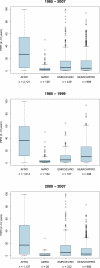The limits and intensity of Plasmodium falciparum transmission: implications for malaria control and elimination worldwide
- PMID: 18303939
- PMCID: PMC2253602
- DOI: 10.1371/journal.pmed.0050038
The limits and intensity of Plasmodium falciparum transmission: implications for malaria control and elimination worldwide
Abstract
Background: The efficient allocation of financial resources for malaria control using appropriate combinations of interventions requires accurate information on the geographic distribution of malaria risk. An evidence-based description of the global range of Plasmodium falciparum malaria and its endemicity has not been assembled in almost 40 y. This paper aims to define the global geographic distribution of P. falciparum malaria in 2007 and to provide a preliminary description of its transmission intensity within this range.
Methods and findings: The global spatial distribution of P. falciparum malaria was generated using nationally reported case-incidence data, medical intelligence, and biological rules of transmission exclusion, using temperature and aridity limits informed by the bionomics of dominant Anopheles vector species. A total of 4,278 spatially unique cross-sectional survey estimates of P. falciparum parasite rates were assembled. Extractions from a population surface showed that 2.37 billion people lived in areas at any risk of P. falciparum transmission in 2007. Globally, almost 1 billion people lived under unstable, or extremely low, malaria risk. Almost all P. falciparum parasite rates above 50% were reported in Africa in a latitude band consistent with the distribution of Anopheles gambiae s.s. Conditions of low parasite prevalence were also common in Africa, however. Outside of Africa, P. falciparum malaria prevalence is largely hypoendemic (less than 10%), with the median below 5% in the areas surveyed.
Conclusions: This new map is a plausible representation of the current extent of P. falciparum risk and the most contemporary summary of the population at risk of P. falciparum malaria within these limits. For 1 billion people at risk of unstable malaria transmission, elimination is epidemiologically feasible, and large areas of Africa are more amenable to control than appreciated previously. The release of this information in the public domain will help focus future resources for P. falciparum malaria control and elimination.
Conflict of interest statement
Figures






References
-
- Sachs J, Malaney P. The economic and social burden of malaria. Nature. 2002;415:680–685. - PubMed
-
- GFTAM. The Global Fund. Who we are what we do. Geneva: The Global Fund to Fight AIDS, Tuberculosis and Malaria (GFTAM); 2007. 36
-
- Curtis C, Maxwell C, Lemnge M, Kilama WL, Steketee RW, et al. Scaling-up coverage with insecticide-treated nets against malaria in Africa: who should pay. Lancet Infect Dis. 2003;3:304–307. - PubMed
Publication types
MeSH terms
Substances
Grants and funding
LinkOut - more resources
Full Text Sources
Medical

